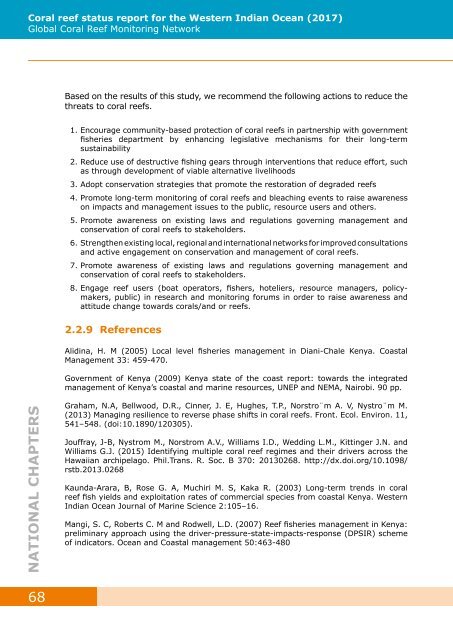GCRMN_COI_2017-Western Indian Ocean Reef Status
GCRMN Western Indian Ocean Coral Reef Status report for 2017. Produced by the Indian Ocean Commission and CORDIO East Africa
GCRMN Western Indian Ocean Coral Reef Status report for 2017. Produced by the Indian Ocean Commission and CORDIO East Africa
You also want an ePaper? Increase the reach of your titles
YUMPU automatically turns print PDFs into web optimized ePapers that Google loves.
Coral reef status report for the <strong>Western</strong> <strong>Indian</strong> <strong>Ocean</strong> (<strong>2017</strong>)<br />
Global Coral <strong>Reef</strong> Monitoring Network<br />
Based on the results of this study, we recommend the following actions to reduce the<br />
threats to coral reefs.<br />
1. Encourage community-based protection of coral reefs in partnership with government<br />
fisheries department by enhancing legislative mechanisms for their long-term<br />
sustainability<br />
2. Reduce use of destructive fishing gears through interventions that reduce effort, such<br />
as through development of viable alternative livelihoods<br />
3. Adopt conservation strategies that promote the restoration of degraded reefs<br />
4. Promote long-term monitoring of coral reefs and bleaching events to raise awareness<br />
on impacts and management issues to the public, resource users and others.<br />
5. Promote awareness on existing laws and regulations governing management and<br />
conservation of coral reefs to stakeholders.<br />
6. Strengthen existing local, regional and international networks for improved consultations<br />
and active engagement on conservation and management of coral reefs.<br />
7. Promote awareness of existing laws and regulations governing management and<br />
conservation of coral reefs to stakeholders.<br />
8. Engage reef users (boat operators, fishers, hoteliers, resource managers, policymakers,<br />
public) in research and monitoring forums in order to raise awareness and<br />
attitude change towards corals/and or reefs.<br />
2.2.9 References<br />
Alidina, H. M (2005) Local level fisheries management in Diani-Chale Kenya. Coastal<br />
Management 33: 459-470.<br />
Government of Kenya (2009) Kenya state of the coast report: towards the integrated<br />
management of Kenya’s coastal and marine resources, UNEP and NEMA, Nairobi. 90 pp.<br />
NATIONAL CHAPTERS<br />
Graham, N.A, Bellwood, D.R., Cinner, J. E, Hughes, T.P., Norstro¨m A. V, Nystro¨m M.<br />
(2013) Managing resilience to reverse phase shifts in coral reefs. Front. Ecol. Environ. 11,<br />
541–548. (doi:10.1890/120305).<br />
Jouffray, J-B, Nystrom M., Norstrom A.V., Williams I.D., Wedding L.M., Kittinger J.N. and<br />
Williams G.J. (2015) Identifying multiple coral reef regimes and their drivers across the<br />
Hawaiian archipelago. Phil.Trans. R. Soc. B 370: 20130268. http://dx.doi.org/10.1098/<br />
rstb.2013.0268<br />
Kaunda-Arara, B, Rose G. A, Muchiri M. S, Kaka R. (2003) Long-term trends in coral<br />
reef fish yields and exploitation rates of commercial species from coastal Kenya. <strong>Western</strong><br />
<strong>Indian</strong> <strong>Ocean</strong> Journal of Marine Science 2:105–16.<br />
Mangi, S. C, Roberts C. M and Rodwell, L.D. (2007) <strong>Reef</strong> fisheries management in Kenya:<br />
preliminary approach using the driver-pressure-state-impacts-response (DPSIR) scheme<br />
of indicators. <strong>Ocean</strong> and Coastal management 50:463-480<br />
68


















